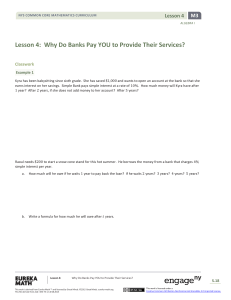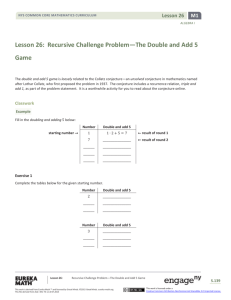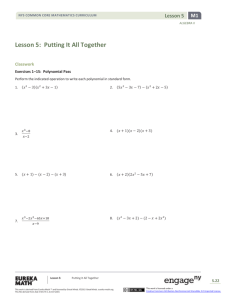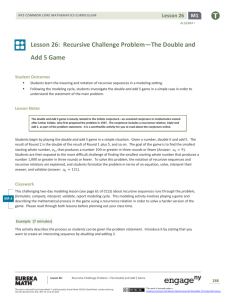Recursive Challenge: Double and Add 5 Game - Algebra I
advertisement
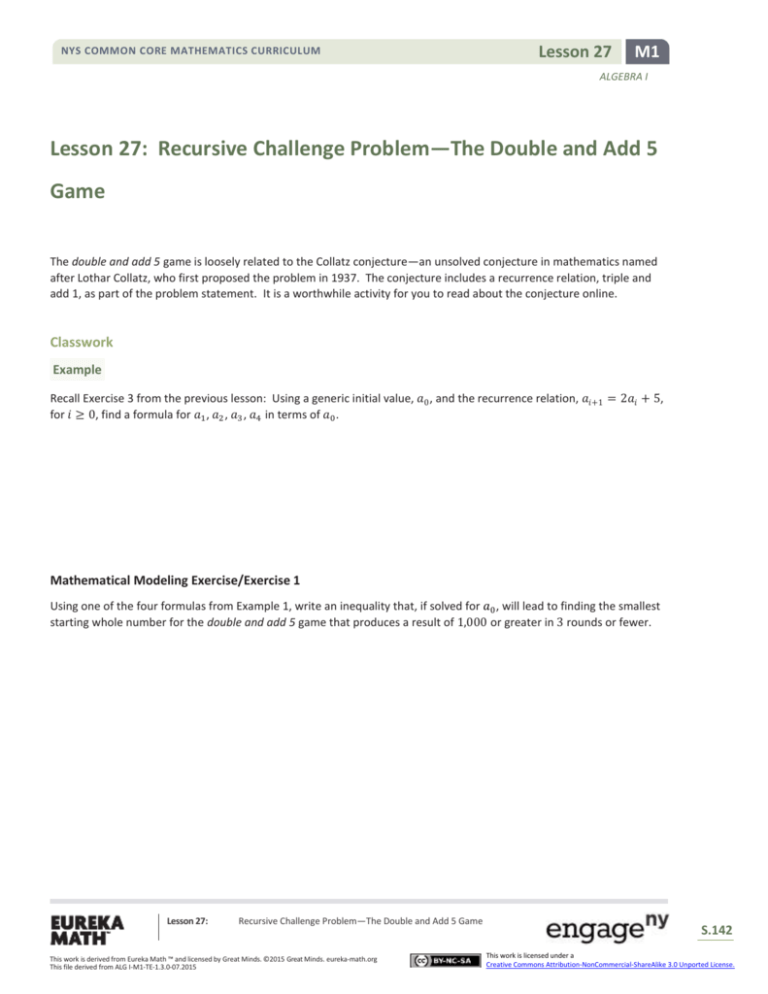
NYS COMMON CORE MATHEMATICS CURRICULUM Lesson 27 M1 ALGEBRA I Lesson 27: Recursive Challenge Problem—The Double and Add 5 Game The double and add 5 game is loosely related to the Collatz conjecture—an unsolved conjecture in mathematics named after Lothar Collatz, who first proposed the problem in 1937. The conjecture includes a recurrence relation, triple and add 1, as part of the problem statement. It is a worthwhile activity for you to read about the conjecture online. Classwork Example Recall Exercise 3 from the previous lesson: Using a generic initial value, 𝑎0 , and the recurrence relation, 𝑎𝑖+1 = 2𝑎𝑖 + 5, for 𝑖 ≥ 0, find a formula for 𝑎1 , 𝑎2 , 𝑎3 , 𝑎4 in terms of 𝑎0 . Mathematical Modeling Exercise/Exercise 1 Using one of the four formulas from Example 1, write an inequality that, if solved for 𝑎0 , will lead to finding the smallest starting whole number for the double and add 5 game that produces a result of 1,000 or greater in 3 rounds or fewer. Lesson 27: Recursive Challenge Problem—The Double and Add 5 Game This work is derived from Eureka Math ™ and licensed by Great Minds. ©2015 Great Minds. eureka-math.org This file derived from ALG I-M1-TE-1.3.0-07.2015 S.142 This work is licensed under a Creative Commons Attribution-NonCommercial-ShareAlike 3.0 Unported License. NYS COMMON CORE MATHEMATICS CURRICULUM Lesson 27 M1 ALGEBRA I Exercise 2 Solve the inequality derived in Exercise 1. Interpret your answer, and validate that it is the solution to the problem. That is, show that the whole number you found results in 1,000 or greater in three rounds, but the previous whole number takes four rounds to reach 1,000. Exercise 3 Find the smallest starting whole number for the double and add 5 game that produces a result of 1,000,000 or greater in four rounds or fewer. Lesson 27: Recursive Challenge Problem—The Double and Add 5 Game This work is derived from Eureka Math ™ and licensed by Great Minds. ©2015 Great Minds. eureka-math.org This file derived from ALG I-M1-TE-1.3.0-07.2015 S.143 This work is licensed under a Creative Commons Attribution-NonCommercial-ShareAlike 3.0 Unported License. Lesson 27 NYS COMMON CORE MATHEMATICS CURRICULUM M1 ALGEBRA I Lesson Summary The formula, 𝑎𝑛 = 2𝑛 (𝑎0 + 5) − 5, describes the 𝑛th term of the double and add 5 game in terms of the starting number 𝑎0 and 𝑛. Use this formula to find the smallest starting whole number for the double and add 5 game that produces a result of 10,000,000 or greater in 15 rounds or fewer. Problem Set 1. 2. 3. Your older sibling came home from college for the weekend and showed you the following sequences (from her homework) that she claimed were generated from initial values and recurrence relations. For each sequence, find an initial value and recurrence relation that describes the sequence. (Your sister showed you an answer to the first problem.) a. (0, 2, 4, 6, 8, 10, 12, 14, 16, … ) b. (1, 3, 5, 7, 9, 11, 13, 15, 17, … . ) c. (14, 16, 18, 20, 22, 24, 26, … ) d. (14, 21, 28, 35, 42, 49, … ) e. (14, 7, 0, −7, −14, −21, −28, −35, … ) f. (2, 4, 8, 16, 32, 64, 128, … ) g. (3, 6, 12, 24, 48, 96, … ) h. (1, 3, 9, 27, 81, 243, … ) i. (9, 27, 81, 243, … ) Answer the following questions about the recursive sequence generated by initial value, 𝑎1 = 4, and recurrence relation, 𝑎𝑖+1 = 4𝑎𝑖 for 𝑖 ≥ 1. a. Find a formula for 𝑎1 , 𝑎2 , 𝑎3 , 𝑎4 , 𝑎5 in terms of powers of 4. b. Your friend, Carl, says that he can describe the 𝑛th term of the sequence using the formula, 𝑎𝑛 = 4𝑛 . Is Carl correct? Write one or two sentences using the recurrence relation to explain why or why not. The formula, 𝑎𝑛 = 2𝑛 (𝑎0 + 5) − 5, describes the 𝑛th term of the double and add 5 game in terms of the starting number 𝑎0 and 𝑛. Verify that it does describe the 𝑛th term by filling out the tables below for parts (b) through (e). (The first table is done for you.) a. Table for 𝑎0 = 1 𝒏 1 2 3 4 Lesson 27: 𝟐𝒏 (𝒂𝟎 + 𝟓) − 𝟓 21 ∙ 6 − 5 = 7 22 ∙ 6 − 5 = 19 23 ∙ 6 − 5 = 43 24 ∙ 6 − 5 = 91 Recursive Challenge Problem—The Double and Add 5 Game This work is derived from Eureka Math ™ and licensed by Great Minds. ©2015 Great Minds. eureka-math.org This file derived from ALG I-M1-TE-1.3.0-07.2015 S.144 This work is licensed under a Creative Commons Attribution-NonCommercial-ShareAlike 3.0 Unported License. Lesson 27 NYS COMMON CORE MATHEMATICS CURRICULUM M1 ALGEBRA I b. c. d. e. 4. 5. Table for 𝑎0 = 8 𝒏 1 2 3 4 𝟐𝒏 (𝒂𝟎 + 𝟓) − 𝟓 _______________ _______________ _______________ _______________ 𝒏 2 3 𝟐𝒏 (𝒂𝟎 + 𝟓) − 𝟓 _______________ _______________ Table for 𝑎0 = 9 Table for 𝑎0 = 120 𝒏 3 4 𝟐𝒏 (𝒂𝟎 + 𝟓) − 𝟓 _______________ _______________ 𝒏 2 3 𝟐𝒏 (𝒂𝟎 + 𝟓) − 𝟓 _______________ _______________ Table for 𝑎0 = 121 Bilbo Baggins stated to Samwise Gamgee, “Today, Sam, I will give you $1. Every day thereafter for the next 14 days, I will take the previous day’s amount, double it and add $5, and give that new amount to you for that day.” a. How much did Bilbo give Sam on day 15? (Hint: You don’t have to compute each term.) b. Did Bilbo give Sam more than $350,000 altogether? The formula, 𝑎𝑛 = 2𝑛−1 (𝑎0 + 5) − 5, describes the 𝑛th term of the double and add 5 game in terms of the starting number 𝑎0 and 𝑛. Use this formula to find the smallest starting whole number for the double and add 5 game that produces a result of 10,000,000 or greater in 15 rounds or fewer. Lesson 27: Recursive Challenge Problem—The Double and Add 5 Game This work is derived from Eureka Math ™ and licensed by Great Minds. ©2015 Great Minds. eureka-math.org This file derived from ALG I-M1-TE-1.3.0-07.2015 S.145 This work is licensed under a Creative Commons Attribution-NonCommercial-ShareAlike 3.0 Unported License.
